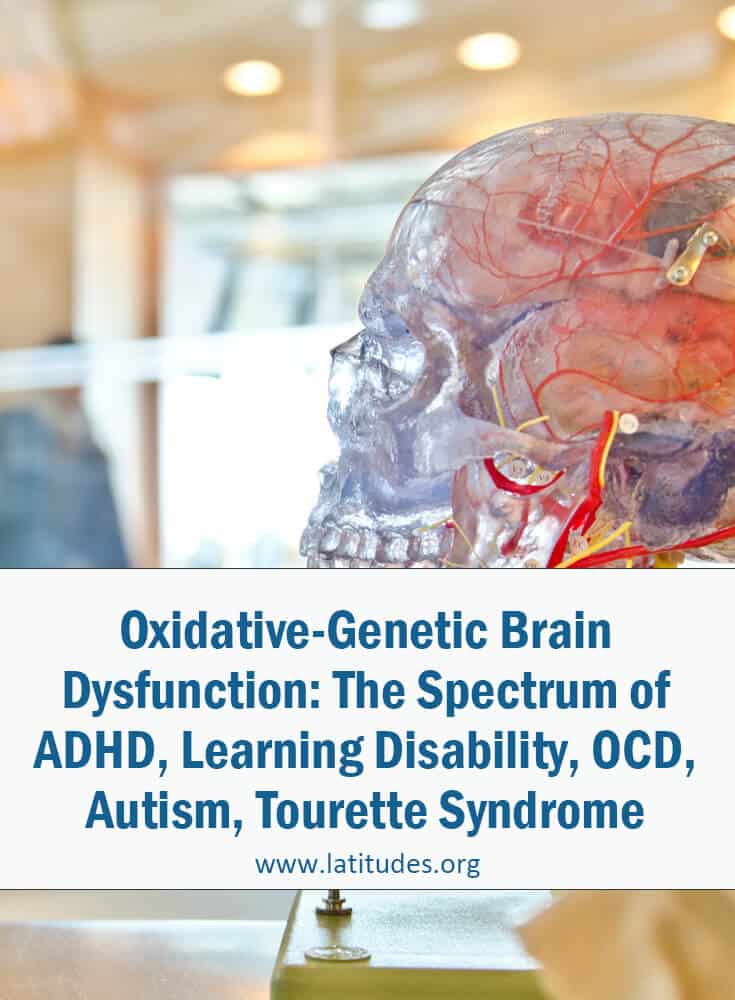Oxidative-Genetic Brain Dysfunction: The Spectrum of ADHD, Learning Disability, OCD, Autism, Tourette Syndrome
 A simple model is presented for understanding the spectrum of Attention Deficit Disorder/Hyperactivity, learning disability, obsessive-compulsive disorder, autism, and Tourette syndrome. In this model, the focus is on developmental and acquired problems of the bowel, liver, and brain ecosystems.
A simple model is presented for understanding the spectrum of Attention Deficit Disorder/Hyperactivity, learning disability, obsessive-compulsive disorder, autism, and Tourette syndrome. In this model, the focus is on developmental and acquired problems of the bowel, liver, and brain ecosystems.
The important genetic factors include: food and mold allergy and the tendency to develop leaky gut lining in the bowel; impaired detoxification in the liver; and neurochemical uniqueness that can cause brain symptoms for some in this spectrum.
The important acquired factors are: chronic sugar overload, antibiotics abuse, and pesticide and other chemical load in the bowel; increased environmental xenobiotic load in the liver; nutritional and metabolic deficiencies that affect the brain function.
What is SHALOAT?
SHALOAT is my acronym for the following syndromes of brain dysfunction: ADD and ADHD, learning disabilities, obsessive-compulsive disorder (OCD), autism, and Tourette syndrome (TS). SHALOAT symptom-complexes are often caused by some known (and undoubtedly many more as yet unknown) genetic and many recognized acquired factors involving the bowel, liver, and brain ecosystems. In this article, I present evidence for my theory that such acquired factors are oxidative in nature. Even though the SHALOAT symptom complexes appear to be related to brain function, I suggest that brain dysfunction is also caused or worsened by genetic and acquired mechanisms involving bowel and liver ecologies.
Why SHALOAT?
There are three important reasons why I propose that the SHALOAT concept of the spectrum of brain dysfunctions is preferable to the prevailing use of individual diagnostic labels.
One: The individual diagnostic labels are mere descriptions of symptomcomplexes. However, there is so much overlap between those symptomcomplexes as to make the specific diagnostic labels useless. I have seen children who were given Ritalin for ADHD and who developed severe OCD as a result of Ritalin therapy. I also have commonly seen children diagnosed to have OCD who suffer from severe attention problems, extreme impulsiveness and destructive tantrums. I recently I saw a three-year-old autistic child who, according to his mother, appeared to learn language normally from 13 to 21 months when he suddenly developed into a classical picture of autism after a viral infection. The same holds for patients with learning disabilities and Tourette syndrome. Of course, the degrees of individual symptoms vary widely.
Two: The diagnostic labels do not give us any insights into the energetic molecular nature of the patient’s suffering. The use of diagnostic labels such as ADHD, OCD, and others only create a false sense of knowledge (or worse, claim of phony expertise) when in reality such labels reveal absolutely nothing about the underlying causes of symptom-complexes. Even though our knowledge is far from complete, advances in molecular and microscopy sciences now make it possible to clearly identify many molecular and microscopic abnormalities in SHALOAT patients. Psychologists and psychiatrists fill tomes with their favorite psychological theories of ADHD, OCD, learning disability, and other disorders, but their books are singularly devoid of specific and objective data about metabolic, nutritional, environmental, and genetic data.
Three: The diagnostic labels are used as the basis for prescribing mind-altering drugs without addressing the underlying bowel, liver, and brain derangements. Many school psychologists promptly use one or the other diagnostic labels when they see SHALOAT children and then refer them to pediatricians who equally promptly write out prescriptions for Ritalin, Cylert, Adderal, or related drugs. No effort is made to search for nutritional, metabolic, and environmental factors that cause the SHALOAT symptom-complexes. That is intellectual bankruptcy, pure and simple. The shortterm use of drugs in many cases is clearly necessary. However, a drug for a SHALOAT child or adult must be prescribed judiciously and only as a component of a broad, integrative management.
The Spreading Scourge
No threats to humankind today are as real, immediate, and calamitous as the ecologic and nutritional hazards our children face — born as well as unborn. The spectrum of SHALOAT is claiming an increasing number of children. Nearly 45 years ago when I began my study of medicine, a medical student could complete his rotation in a pediatric clinic without encountering a single child disabled by any of these disorders. Now, hardly a day passes when I do not hear one or more heart-rending descriptions of a mother agonizing over her child’s anguish.
Symptom-complexes of SHALOAT are caused by genetic, nutritional, metabolic, and environmental factors. How do my colleagues and I care for the SHALOAT children? The first essential point is: We do not treat diseases. We try to care for children with neurochemical uniquenesses which make them vulnerable to sudden shifts in brain function. Our primary task is to demonstrate to such children and their parents the relationships between their choices in the kitchen and environmental factors, and how they affect them at home and school. We seek to lead them through a journey of self discovery.
Genes Legislate Life; Environment Interprets Those Laws
In understanding the true nature of SHALOAT, we must first clearly understand the relationship between genes and environment. Disorders included in the SHALOAT spectrum often run in families. In RDA: Rats, Drugs and Assumptions, I wrote that genetic codes are like obscure penal codes-they remain dormant until they are activated by environmental triggers. If this were not so, a hyperactive child would be hyperactive all the time and a child with Tourette syndrome (TS) would suffer tics all the time. Mothers of hyperactive children and those with TS know that is not so — and so do physicians who care for children afflicted with those disorders.
Structural lesions in the brain affect intellectual, sensory, and motor functions of the body. Functional biochemical derangements also create similar difficulties. Recent advances in medical technology allow us to define these lesions in ways that could not have been foreseen only a few decades ago. What is even more remarkable is that such technology also permits us to recognize when, and in many instances, how, environmental triggers cause abnormal responses.
The Troubled Bowel, Liver, and Brain Trio
SHALOAT encompasses a broad spectrum of brain symptom-complexes caused by damage to the bowel, liver, and blood ecosystems. The ecosystem damage is caused by some inherited factors and by excessive oxidative stress. It is critical to recognize that even though those symptom-complexes seem related to the brain, the SHALOAT states are metabolic problems first, and neurologic derangements second.
In the bowel, the important genetic factors are food and mold allergy, gut immune deficits, and digestiveabsorptive dysfunctions … The acquired factors involving the bowel ecosystem are overgrowth of primordial microbes, damaged bowel lining (mucosa), and chronic inflammation caused by sugar overload, antibiotic abuse, and pesticide overload. As for genetic factors involving the liver, firm evidence of impaired detoxification in the liver has been published by many researchers. The data indicate failure of oxidative enzymes involved in the detox reactions. Acquired factors include excess production of toxins (such as tartaric acid) by primordial microbes in the bowel, excess microclot formation in the blood (oxidative coagulopathy), and environmental pollutant burden on the liver. Strong clinical evidence for the role of the liver in the production of SHALOAT symptomatology is provided by clinical benefits observed with detox therapies.
From the Liver to the Brain
When carefully tested, many SHALOAT children show evidence of impaired detoxification in the liver. Such defects in detoxification cannot be uncovered with the commonly performed tests for liver function such as liver enzymes, gamma globulin proteins, and bilirubin. Indeed, this is the main reason most pediatricians and psychiatrists fail to understand the significance of the role of liver-related factors in the production of the SHALOAT symptom-complexes. Abnormally high levels of D-glucaric acid in the urine provides clear evidence of impaired detoxification in that organ. Furthermore, measurements of many xenobiotics in the blood or urine of many SHALOAT children reveal abnormally high levels, again indicating inadequate detox activity. Some light on the role of impaired liver detox in the production of symptoms is shed by considering the case of an alcoholic whose liver develops cirrhosis and then cannot perform its detox functions well. The term hepatic encephalopathy is used to describe the neurologic symptoms which he develops.
Oxidative-Genetic Brain Dysfunction: A Unifying Theory
The principal strength of the oxidativegenetic brain dysfunction theory of SHALOAT is that it shifts the focus from the use of drugs for hollow diagnostic labels to a diligent search for nutritional, allergic, environmental, metabolic, and detox factors that cause and/or trigger symptom-complexes. Specifically, oxidative-genetic brain dysfunction requires careful consideration of all energetic-molecular events that take place in the bowel, liver, and brain ecosystems.
Essentials of Management
- Diagnose and treat mold allergy and other types of inhalant allergy. Detect and manage food sensitivities. Avoid rapid hyper- and hypoglycemicshifts (metabolic roller coasters) and other adverse food effects. Increase alkaline ash foods (vegetables).
- Maintain optimal hydration. Restore bowel ecology. Prescribe probiotics and natural antifungal agents (i.e. echinacea and goldenseal drops) liberally.
- Use Nystatin when clinically indicated.
- Nutrients of special value include glutathione, taurine, vitamin B6, zinc, dimethylglycine or trimethylglycine (betaine), multi-mineral, multivitamin, selenium, chromium, and molybdenum. Select vitamin injections may be recommended in some cases.
The Benefits of a Unifying Model
- The benefits of a unifying model of oxidative-genetic brain dysfunction include:
- It shifts the focus away from needless controversy about a large number of diagnostic labels in vogue for children and adults who suffer from a host of clearly overlapping symptom-complexes related to brain dysfunction.
- It recognizes the central role of genetic predispositions (neurochemical uniquenesses) that create certain handicaps yet are associated with above-average potential for creativity in many instances.
- It clearly identifies certain ecologic derangements and stresses that profoundly influence the frequency and intensity of symptoms and can be effectively managed by focusing on the bowel, blood, and liver ecosystems.
- It highlights the importance of certain nutritional factors for controlling symptoms and promoting health.
Additional Reading
Ali M, Ali O, Fayemi, AO et al. Efficacy of an integrative program including intravenous and intramuscular nutrient therapies for arrested growth. J Integrative Medicine 1998;2:56-69.
Ali M. Darwin, Oxidosis, Dysoxygenosis, and Integration. J lntegrative Medicine 1999;1:1116
Ali M. Oxidative regression to primordial cellular ecology: Evidence for the hypothesis and its clinical significance. J Integrative Medicine 1998;2:4-49.
Edeleson, SB, Cantor DS. Autism: Xenobiotic influences. Toxicology and Industrial Health 1998;14:553-563.










Hi, I have severe OCD and received some test results back from my NP, one result worth mentioning is having very high glucarate levels (urine). I’ve not come across much online re. OCD and glucarate levels, but if there is a strong relationship btwn liver and OCD, etc. I’d be curious to know more about it. Are there more recent articles covering this topic that you’d recommend? Any studies? Thank you!